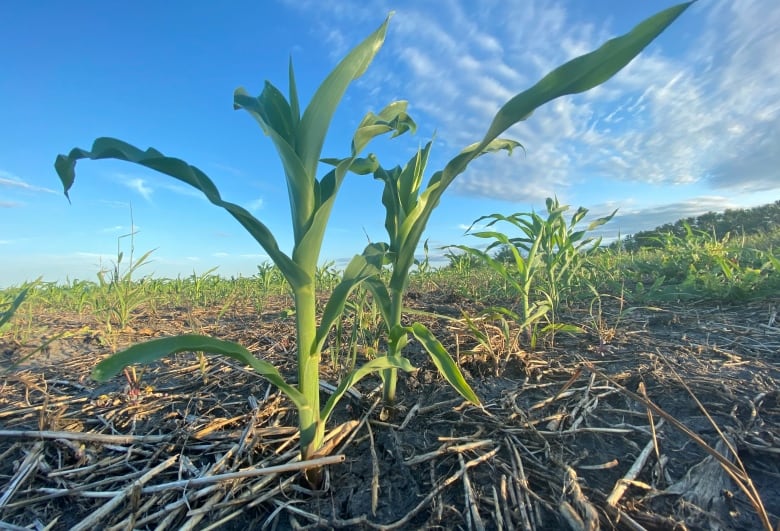
Jason Bednarek has never seen drought this bad in Manitoba’s Interlake region, and midway into July, the third-generation farmer is already racked with worries about what he’ll have to do to make it through winter.
“I can’t even put it into words how bad it is,” said Bednarek, owner of 2B Land and Cattle. “I’ve never seen it worse.”
Bednarek doesn’t know how he’ll be able to keep his 2,000 calves near Ashern fed after a lack of rain and sweltering heat this season has left him with a shortage of hay and other crops for feed.
With more prolonged heat warnings on the horizon, he and others are faced with the difficult decision of selling off large quantities of livestock at auction.
“The damage is done,” he said. “The only solution is to stop the bleeding and slaughter the cows.”
Bednarek is one of many Manitoba livestock farmers facing a devastating season due to drought.
Rain deficits long before summer made for an elevated drought risk that has since become a reality. A couple of Manitoba municipalities have already declared states of agricultural disaster.
And things aren’t likely to improve much anytime soon.

Prolonged heat waves will be more common
Environment Canada predicts a series of heat warnings will be in effect through much of central and southern Manitoba for the rest of the month, bringing consistent daily temperatures over 30 C, said agency meteorologist Alysa Pederson.
The effects of climate change mean in years to come, these prolonged heat waves will become more and more common, she said.
The average total precipitation from September to June is about 365 millimetres for Winnipeg and 335 for Brandon, she said. Those places received about half that — 185 and 186 millimetres, respectively — during the latest September to June period, said Pederson.

The coming stretch of heat means the conditions could get worse before they get better for livestock producers struggling to find feed.
“I sympathize, and my heart goes out to these guys,” said Trevor Hadwen, an agroclimate specialist with Agriculture and Agri-Food Canada who works on the federal agency’s drought reports, which can serve as an early warning sign.
“It’s something we are watching extremely closely.”
‘Exceptional’ twice-a-century drought
The latest report came out last week. It’s based on precipitation levels from September of last year to June 30 and comes from a combination of hydrological, meteorological, agriculture and socio-economic data.
That report suggests large swaths of central and southern Manitoba, as well as the Interlake, are facing “extreme” and “exceptional” droughts not seen in decades.
An extreme drought is an event that normally happens only once every 20 to 50 years, said Hadwen, and an exceptional drought is defined as a twice-in-a-century event.

Areas around Brandon, as well as communities straddling the Canada-U.S. border in southern Manitoba, are experiencing exceptional drought, the most severe rating in the agency’s report. The same is true for much of Interlake.
Statistically speaking, that suggests those spots haven’t been this dry since around 1970, said Hadwen.
Dauphin, Brandon and areas in and around Winnipeg are experiencing extreme drought and some of the driest conditions in the past five years.
Anecdotally, Hadwen said, his agency continues to hear reports from farmers about how this year compares to 1988, when a severe drought ravaged much of Western Canada, particularly in the southern Prairies.
“I fully understand that,” he said. “We are beating those numbers all over the place in terms of rainfall deficits.”
A need for more than just hay
One multigenerational farming family in the Ashern area is expected to sell its entire herd in the coming weeks, said Kirk Kiesman, a farmer and the general manager of the Ashern Auction Mart.
“There’s tears,” said Kiesman, who has been farming in the Ashern area for about a decade and has about 220 cattle.
Another cattle producer in his 80s told Kiesman this drought is worse than the one in 1988, largely because at that time, farmers could drive somewhere nearby to buy feed.
“No one ever wants to see their breeding stock be sold for meat,” Kiesman said.

“Everyone’s trying to scrounge up as much feed to keep as many of the mama cows as they can, but, you know, there’s a point where you have to decide that no, some of these cows are going to have to go.”
The Ashern auction normally doesn’t start until the final week of August. This year, it started about two months early, and organizers anticipate holding emergency drought auctions every two weeks through summer, said Kiesman.
Many in the Interlake region have no idea where 90 per cent of their hay and other feed will come from in the months ahead due to stunted growth from a lack of rain, he said.
He continues to hear from numerous farmers who, like him, are facing challenges on the feed front.
The coming months look bleak for many. Manitoba offers online and telephone counselling for farmers and other people in rural areas who need someone to talk to.
Kiesman says it’s important to stick together.
“It’s important to have someone that if you need to cry, you can cry, and if you need to yell, you can yell,” he said.
“That’s all important things that guys need to remember — that they’re not by themselves.”













